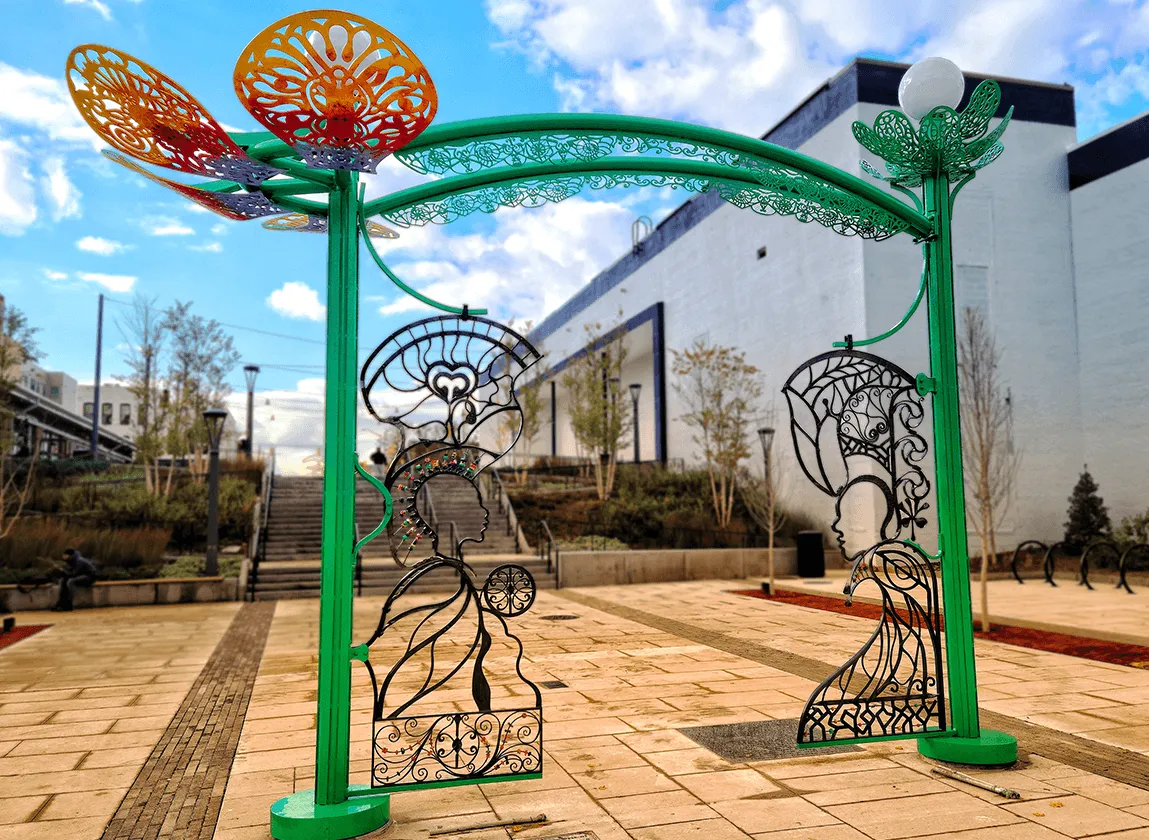A new forged-iron sculpture, its elegant curves accented in bright hues, now graces the plaza of the marketplace where one of its subjects was once sold—and the other worked—as a slave. Titled “Robert and Rosetta” and designed by Christopher Kojzar, an Andrew Harris Fellow in UVM’s Program in Art and Art History, and his mother, noted artist Oletha DeVane, the artwork memorializes two enslaved people whose stories might otherwise be lost to history. It was recently installed as a permanent outdoor fixture in Baltimore, Maryland’s Lexington Market.
The project began when Kojzar and DeVane were selected as a team to create a piece for the Lexington Market space. “My mom is from Baltimore,” Kojzar says, “and I spent some time living there, so the idea of doing a project in Lexington Market felt right.” Built in the late 1700s and recently reopened after extensive renovation, Lexington Market was one of the first open-air markets in the country.
“One thing that stuck out was that [the developer] was looking for a work that had some historical relevance to the market space,” Kojzar says, adding that he and his mother often look to unsung heroes in Black history when creating their art. “That’s been a part of a natural flow of the practice,” he says, “giving these people their humanity, in a way, and telling stories that are hidden in plain sight.” The idea for the sculpture came after talking with Baltimore-based public historian Dean Krimmel and discovering a couple of intriguing newspaper mentions from the 1830s.
One notice, from 1838, advertised the forthcoming sale at the market of an enslaved individual name Rosetta. The other, dated 1833, offered a $50 reward for an enslaved man named Robert who had left a plantation on which he had been forced to toil—work that included time spent in Lexington Market selling butter for Governor George Howard, the plantation’s owner and namesake for Howard County, Maryland. “We decided these stories were really telling in how people recognize the market and also in the historical artifact of surveillance structures and forced labor placed on Black people in this country’s past,” Kojzar says.
During the period in which Robert and Rosetta lived, free and enslaved Blacks intermingled in Baltimore. “Lexington Market was not primarily an auction site for slaves,” Kojzar says, “but that’s not to say that other slaves weren’t sold there.”
Once the subjects were chosen, Kojzar and his mother looked to local architecture for inspiration. “The market is in an area known for its wrought-iron design,” Kojzar says. So, they decided to create two panels made from forged wrought iron that were then painted, filigreed, and assembled to form an archway. The respective newspaper notices about Robert and Rosetta, in the original newspaper fonts, were etched into granite markers in the ground at the base of the artwork.
“My mother started with very simple drawings,” Kojzar says, “sketching several different kinds of panels incorporating African or Art Nouveau motifs with a lot of whimsical, wavy line work.” Next, they made large pencil sketches that Kojzar digitized it into a 2D format. He then created a three-dimensional rendering using a software program called Maya. Finally, Nicholas Ireys, of Baltimore-based NI Metal Design, forged the sculpture.
Kojzar and DeVane, whose career in Baltimore as a multidisciplinary artist has spanned 40 years, first worked together eight years ago on the collaborative exhibit “Inside/Outside” at the Creative Alliance in Baltimore, MD. And DeVane recently had another piece erected in Owings Mill, Maryland called “The Memorial to Those Enslaved and Freed,” for which Kojzar worked as the Alternate Artist, a consultant, draftsman, and computer renderer. “It was really engaging working with my mother,” Kojzar says. “She’s much more intuitive, whereas I’m more detail-oriented. Sometimes we clash, but we resolve our differences through conversation. It’s like this family vibe.”
The significance of being an Andrew Harris Fellow, named for the first African American UVM graduate, isn’t lost on Kojzar. Harris, who was also the first African American U.S. college graduate to champion the abolition of slavery and advocate equality for people of color, graduated in 1838—the same year in which Rosetta was auctioned off at the Lexington Market. “I don’t take for granted what Andrew Harris had to do to get an education or to reach his potential,” Kojzar says.
“Public art can be hard to sit with,” Kojzar adds. “We walk or drive by a lot of places where we see the art and it just becomes a part of the architecture or the landscape.” His hope now is that people will take time to sit with “Robert and Rosetta” and reflect not only on the artwork itself but also on the stories behind it.
